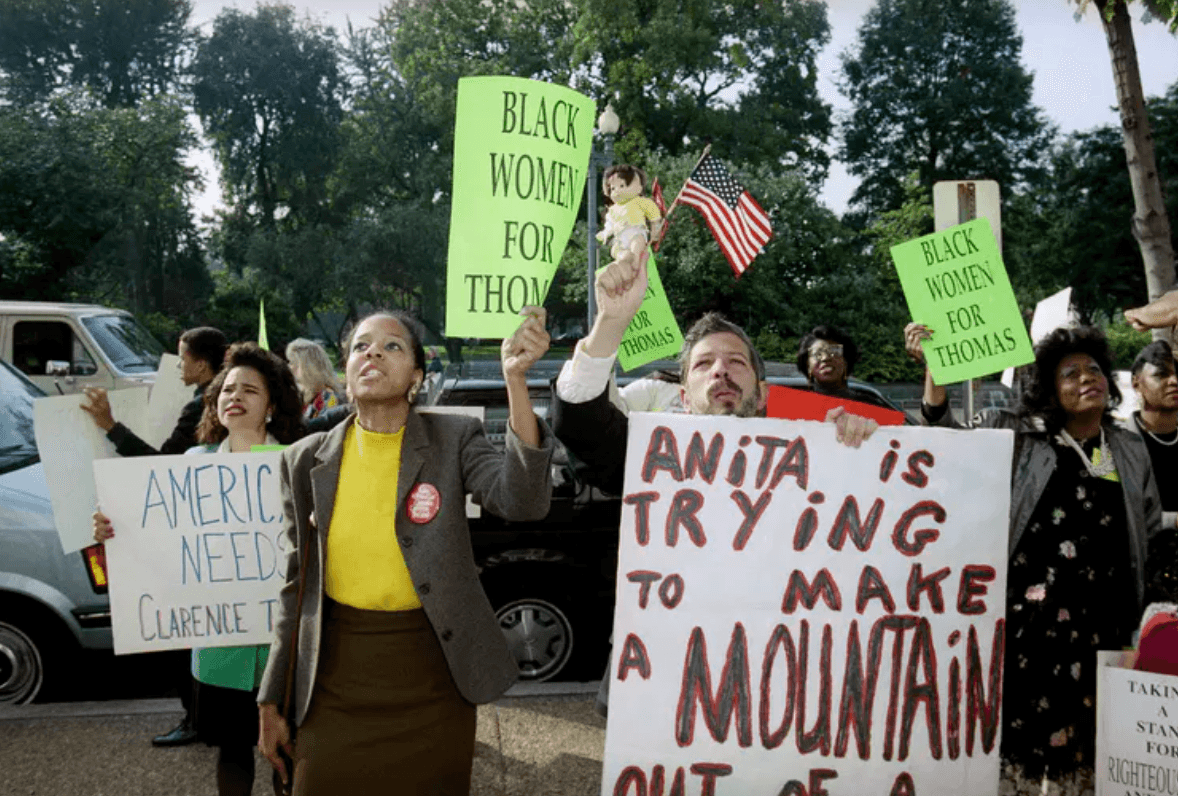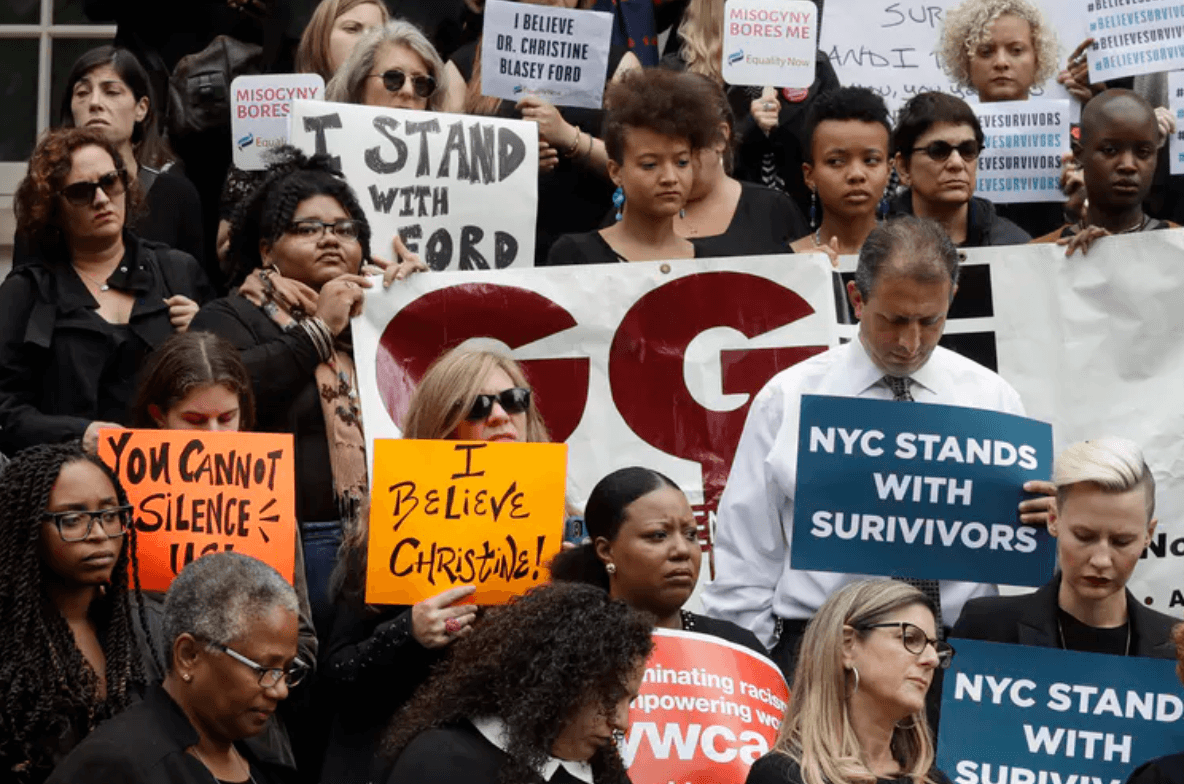Things have changed since Anita Hill – sort of
Counsel Charles Ogeltree uses a legal pad to cover a microphone as he advises law professor Anita Hill during her testimony, Oct. 11, 1991, before the Senate Judiciary Committee hearings on Supreme Court nominee. Judge Clarence Thomas. Hill testified she was sexually harassed by Thomas while she was his aide; Thomas has denied the charges.
In 1991, Anita Hill accused Supreme Court nominee Clarence Thomas of sexual harassment. Thomas was nonetheless confirmed. Now, as Brett Kavanaugh faces an allegation of sexual assault, observers are saying that “things have changed since Anita Hill.”
Have they?
As a scholar who studies gender dynamics in organizations, I believe the question of whether the #MeToo, #TimesUp and related movements have ushered in significant change is intertwined with three other questions, for which there has been some research:
- Are sexual harassment and sexual assault still as common?
- Are women now more ready to report?
- Are women’s reports taken more seriously?
Anita Hill’s experience involved workplace sexual harassment that was sustained over time. Christine Blasey Ford reported an attempted rape at age 15 that was a traumatic, intense one-time incident. Yet there are also clear similarities: similar alleged sexualized mistreatment, similar last-minute accusation derailing what seemed to be a foregone conclusion, similar male-dominated group standing in judgment, similar strong feelings from the public.
On the surface, the parallels are uncanny.
Measuring change
Are sexual harassment and sexual assault as common now as they were in the early 1990s?
The research suggests that sexual harassment and sexual assault still happen at alarming rates, but assessing change over time is complicated.
In terms of sexual harassment, a detailed 2016 report by the federal Equal Employment Opportunity Commission summarized decades of research, including studies that found that 85 percent of women had experienced some form of sexual harassment.
Across studies, researchers have found that the more blatant forms of sexual harassment, such as threats or coercion, are somewhat less common than when Anita Hill accused Thomas, while the hostile work environment forms, such as sexist and sexualizing comments and sidelining of women, still abound.
These studies show that sexual harassment rates remain particularly high for women of color and for women who are isolated, economically vulnerable, or in settings where more traditional beliefs about gender roles are held — or a combination of all those factors. Not much seems to be changing in terms of these dynamics. But survey studies do not tend to look at incidence year by year.
Data about legal claims provide some insights about change over time. There were 10,500 reports of sexual harassment filed with the federal Equal Employment Opportunity Commission in 1992, the year after Hill testified; 11,300 such cases came before the commission in 2011.

In terms of sexual assault, the Department of Justice estimates that rates have fallen 63 percent since 1993, from 4.3 assaults per 1,000 people in 1993 to 1.6 per 1000 in 2015. But it’s important to avoid confusing this reduction with “problem solved.” One recent poll reveals that about 25 percent of college-age women reported being sexually assaulted in 2015.
The findings summarized above do not lead to a definitive conclusion that harassment has gone up or sexual assault has gone down. There are at least two complicating factors.
First, in what seems like a contradictory finding, reports often go up, not down, following interventions designed to reduce sexual harassment. Rather than signaling spiraling incidence, increased reporting is often intertwined with increased awareness of what constitutes unacceptable behavior.
Equal Employment Opportunity Commission numbers have ebbed and flowed over the years with reports rising to over 15,000 per year in the late 1990s after Anita Hill’s testimony. It would not be surprising if the number of cases goes back up in the next few years after the past year’s events. And such an upsurge may well represent progress because it may say more about changing norms about how women should be treated than about the incidence of harassment and discrimination.
Researchers have also found that saying “yes” to a survey item that simply asks “have you ever been sexually harassed” hovers in the 25 percent range. However, many of the same respondents who say they have not been “sexually harassed” will say yes when asked whether they have been “threatened if you did not cooperate with a bosses’ sexual advances.”
Second, the risk of relying on formal reporting, such as the Equal Employment Opportunity Commission or Department of Justice data, is that this only captures the cases where women filed a formal report. This brings us to question number two: Are women now more likely to report to authorities?
Minimal reporting
The vast majority of cases of harassment or assault are not reported to anyone in authority. This was true in the time of Anita Hill, and it remains true.
Studies reveal that as many as 90 percent of women who experience workplace harassment never report it. That has led the Equal Employment Opportunity Commission to conclude that the least common response to harassment is to take some sort of formal action.
Decades of research have shown that women also have rarely reported sexual assaults, and that is true to date. In a 2015 survey of more than 1,000 college aged students, only 12 percent who said they had been sexually assaulted reported the incident to police or other authorities. About a quarter of all survivors never told anyone – not even a close friend.
A recent Department of Justice report estimates that only 23 percent of sexual assaults in 2016 were reported to police, compared to 58 percent of aggravated assaults.
The reasons why gender violence is not reported have also not changed much over the years. Women — then and now — have good reason to worry that they might be shamed, disbelieved, humiliated and ostracized.

Changes in culture
The personal struggle around whether reporting an incident is worthwhile is grounded in an understanding of the real costs – emotional, relational, economic and professional. And that leads to the third question: Are women taken more seriously now than they have been in the past?
In some pockets, yes; in others, clearly no.
There is not yet much empirical evidence of changes in societal attitudes about sexual harassment and sexual assault since #MeToo. One thing we do know, however, is that the accusations in both Supreme Court situations are engendering similarly strong reactions from political commentators, senators and the general public.
In response to Anita Hill, 1,600 African American women took out an ad in The New York Times to indicate their support. More than 1,000 of Ford’s fellow students have signed a letter that attested to the rape culture that surrounded their shared high school experience. Then and now, the accusations ring true for many other women.
The #MeToo movement has clearly triggered greater discussion not only in social and traditional media, but also in public discourse, academic panels and special issues of professional journals.
Yet, these indicators beg the question of whether reports of gender violence are taken seriously by powerful decision-makers.
The efforts to discredit Ford’s allegations are reminiscent of responses to Anita Hill and are clearly so entangled with political agendas that thoughtful, serious reactions to the allegations are getting drowned out by talking points. Those include questioning the timing of the polygraph or casting a reluctance to come forward as something other than a well-founded worry about being shamed in public.
Here is what we know more generally: Studies reveal that employees — both men and women — who speak up about workplace harassment face retaliation, trivialization, hostility and reprisals. One study found that 75 percent of formal reports of workplace harassment were followed by some form of retaliation, ranging from shunning by coworkers to denial of a promotion. Women also face doubt and blame when they report sexual assault – some even refer to the response as a second rape.
Have things changed?
Perhaps.
Public awareness of both sexual harassment and sexual assault seems to have gone up, but rates remain troubling and the barriers to reporting and being taken seriously remain unchanged.
If the Senate Committee supports a full, respectful investigation that is outside of the political circus, and waits to hold a vote on confirmation of Kavanaugh until after all the facts are in, then we could conclude that something significant has shifted.![]()
Meg Bond is a professor of psychology at the University of Massachusetts Lowell. This article is republished from The Conversation under a Creative Commons license. Read the original article.
